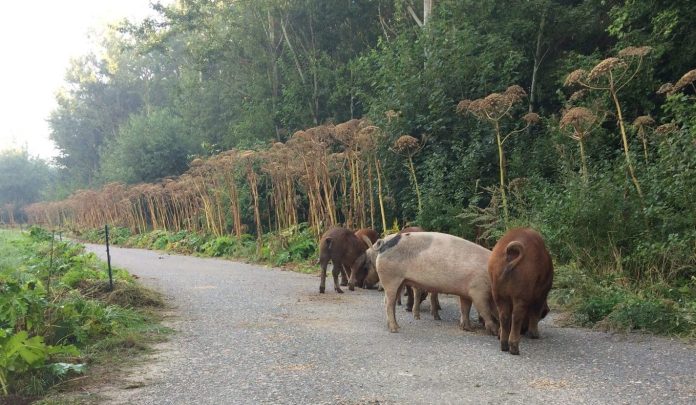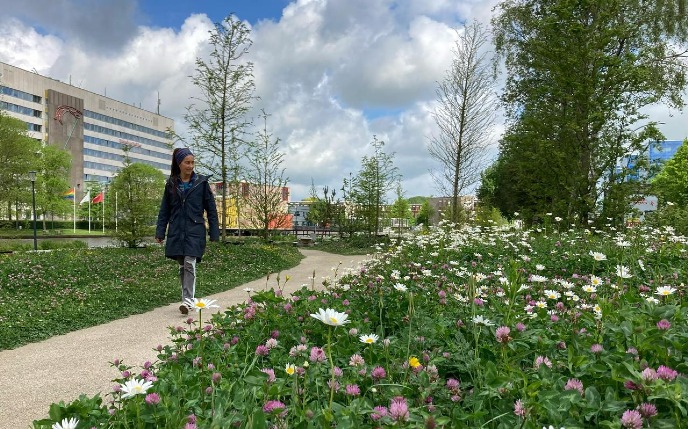Biodiversity policy
The University of Groningen aims to focus more on ecology and biodiversity in the general management and grounds maintenance of Zernike Campus (as reflected in the Sustainability Roadmap).
What is Biodiversity?
Life on Earth has many variations. Whether it concerns the smallest bacteria, fungi and plants or the largest animals, the tropical rainforests or the Dutch meadows, every life form, every ecosystem and every genetic variation is unique and irreplaceable. We call this great diversity 'biodiversity'. Unfortunately, biodiversity and associated ecological values are under pressure because of human interference. In addition, the generation that is growing up now can only form a limited idea of what nature looked like 30 years ago, for example, which makes it increasingly difficult to make the loss of biodiversity tangible.
Biodiversity at the UG
The University of Groningen has the ambition to focus more on ecology and biodiversity. The ambition is to increase the biodiversity of UG sites by adopting a different management method, based on a target species policy. In practice you can think of waterways with (partly) natural banks and more flowery grassland with herbs for butterflies, bees, dragonflies and other insects. So-called fringes and mantles can be developed along forest edges as a foraging area for insects, amphibians, reptiles, birds, small mammals and bats. There are not only oppportunities for biodiversity on the Zernike campus, but there also around the buildings in the city center.

Zernike Campus
The opportunities relating to ecology and biodiversity can mainly be found on Zernike grounds, seeing as the other UG buildings and grounds are generally located in the city centre. Zernike Campus borders the Municipal Ecological Structure (Gemeentelijke Ecologische Structuur, GES) of Groningen: a large network of green areas and bodies of water in the municipality of Groningen. These areas are ecologically managed and monitored. In order to also monitor Zernike Campus, the methods used for the GES areas will be adopted. Exploratory research has been done and a baseline measurement and annual monitoring will be conducted.
Natural management
The intention is to increase biodiversity (via a target species policy) by managing the area. Management activities include the mowing policy, ditches with (partial) natural banks, meadows comprising more wild flowers , re-wilding grassland, and more herbs for butterflies, bees, dragonflies, and other insects. So-called hems and mantles can be developed along woodland boundaries to create a foraging area for insects, amphibians, reptiles, birds, small mammals, and bats. Green waste will be processed locally by means of Bokashi (pits in which green waste can be fermented). (Source: Verkennend onderzoek Zernike Campus [Zernike Campus exploratory research], 2020)

Who's working on biodiversity at the UG?
"My name is Cathy Hermans. I am working for Terrain Management at the University of Groningen. In this department we are, among other things, working on the transition from traditional to sustainable and ecological terrain management within the University of Groningen. We do this by increasingly using machines on batteries instead of fossil fuels; by using sheep for maintenance of extensive grass management, pigs for combating invasive exotic plant species and by managing in a more phased manner (not mowing or sawing everything at once, but a part each time). I come from forest and nature management, have been retrained as a landscape gardener and have been a green, gray (pavement, etc.) and blue (water) developer for years."

You might be surprised that many opportunities relating to ecology and biodiversity can be found on Zernike grounds. If you would like to know more about this you can take the audio tour at the Zernike Campus.
The tour starts at the decking next to the Duisenberg pond and works by scanning the QR-codes on the panels. Don't forget your earphones!
